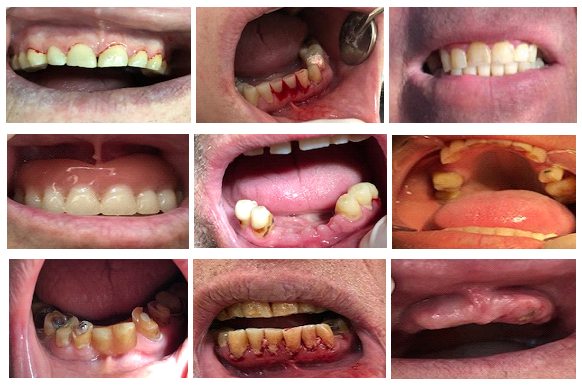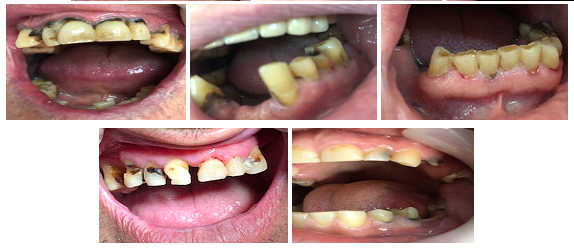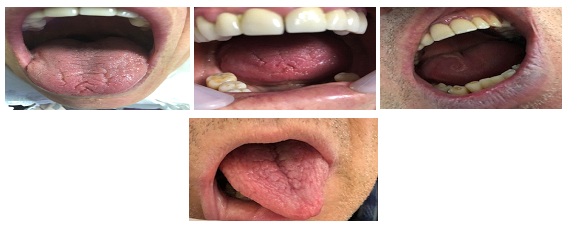Geriatric Patients: Data on Dental Problems at this Age
Article Information
Saimir Heta1, Merilda Tarja2, Sonila Kapaj3, Eduard Kapaj3, Ermelinda Gina Milo4, Ilma Robo2*
1Depatment of Pediatric Surgeon, Pediatric Surgery Service, Tirana, Albania
2Department of Periodontology, Faculty of Medical Sciences, Albanian University, Tirana, Albania
3Depatment of Gynecology and Obstetrics, Fier Maternity, Obstetric Physician, Tirana, Albania
4Dental Clinic, Tirana, Albania
*Corresponding author: Ilma Robo, Department of Periodontology, Faculty of Medical Sciences, Albanian University, Tirana, Albania.
Received: 01 November 2019; Accepted: 03 November 2019; Published: 06 November 2019
Citation:
Saimir Heta, Merilda Tarja, Sonila Kapaj, Eduard Kapaj, Ermelinda Gina Milo, Ilma Robo. Geriatric Patients: Data on Dental Problems in this Age. Archives of Internal Medicine Research 2 (2019): 070-076.
View / Download Pdf Share at FacebookAbstract
Introduction: As the age increases, the frequency of hearing loss, visual impairment, cataract and glaucoma is increased. Most of the geriatric patients suffer from at least one chronic disease. The aim of the study is the evaluation of the presence of dental problems in geriatric age and comparison of the frequency of lesion manifestations of pre-geriatric age.
Material and methods: In a sample of 73 ad-hoc presented patients, at the University Clinic, Albanian University, for dental treatments, data on the oral status of geriatric patients were collected over a period of 2 weeks, 7-21 May 2019. The conditions for inclusion in the study were the age of the patient, 50 years and over. The mean age of geriatric age is 65 years, but the age of the study was decided to compare the elements of dental problems before the geriatric age, such as a pre-geriatric specimen or geriatric pathologies. Patients were evaluated for age, degree of education, number of teeth in the oral cavity, number of replaceable teeth, number of teeth with caries in the tooth crown, number of denture teeth in the tooth root, number of teeth with gingival recession 3 or more mm. etc.
Results: Regardless of the age distribution, almost 55% of the oral cavities are full of natural tooth, the fixed prosthesis is at the highest level at age 50-65 years. Independently of the gender, the average age of the patients involved is almost the same 67 years. Crown caries expresses the highest level of 14% at oral cavity at 66-90 years of age, caries of root amounted to 14% of oral cavity at 50-65 years of age. Xerostomia appears at 13% in the age 50-65 years, and 20% in the age of 66-90. Gingival recession and loss of attachment express the highest values at male patients, with a value over 3mm.
Conclusions: At geriatric patients, the aim should be to reduce the number of bacteria in the m
Keywords
Geriatric Patients, Periodontal Pathologies, Caries, xerostomia
Geriatric Patients articles Geriatric Patients Research articles Geriatric Patients review articles Geriatric Patients PubMed articles Geriatric Patients PubMed Central articles Geriatric Patients 2023 articles Geriatric Patients 2024 articles Geriatric Patients Scopus articles Geriatric Patients impact factor journals Geriatric Patients Scopus journals Geriatric Patients PubMed journals Geriatric Patients medical journals Geriatric Patients free journals Geriatric Patients best journals Geriatric Patients top journals Geriatric Patients free medical journals Geriatric Patients famous journals Geriatric Patients Google Scholar indexed journals Periodontal Pathologies articles Periodontal Pathologies Research articles Periodontal Pathologies review articles Periodontal Pathologies PubMed articles Periodontal Pathologies PubMed Central articles Periodontal Pathologies 2023 articles Periodontal Pathologies 2024 articles Periodontal Pathologies Scopus articles Periodontal Pathologies impact factor journals Periodontal Pathologies Scopus journals Periodontal Pathologies PubMed journals Periodontal Pathologies medical journals Periodontal Pathologies free journals Periodontal Pathologies best journals Periodontal Pathologies top journals Periodontal Pathologies free medical journals Periodontal Pathologies famous journals Periodontal Pathologies Google Scholar indexed journals Caries articles Caries Research articles Caries review articles Caries PubMed articles Caries PubMed Central articles Caries 2023 articles Caries 2024 articles Caries Scopus articles Caries impact factor journals Caries Scopus journals Caries PubMed journals Caries medical journals Caries free journals Caries best journals Caries top journals Caries free medical journals Caries famous journals Caries Google Scholar indexed journals xerostomia articles xerostomia Research articles xerostomia review articles xerostomia PubMed articles xerostomia PubMed Central articles xerostomia 2023 articles xerostomia 2024 articles xerostomia Scopus articles xerostomia impact factor journals xerostomia Scopus journals xerostomia PubMed journals xerostomia medical journals xerostomia free journals xerostomia best journals xerostomia top journals xerostomia free medical journals xerostomia famous journals xerostomia Google Scholar indexed journals Pediatric Surgeon articles Pediatric Surgeon Research articles Pediatric Surgeon review articles Pediatric Surgeon PubMed articles Pediatric Surgeon PubMed Central articles Pediatric Surgeon 2023 articles Pediatric Surgeon 2024 articles Pediatric Surgeon Scopus articles Pediatric Surgeon impact factor journals Pediatric Surgeon Scopus journals Pediatric Surgeon PubMed journals Pediatric Surgeon medical journals Pediatric Surgeon free journals Pediatric Surgeon best journals Pediatric Surgeon top journals Pediatric Surgeon free medical journals Pediatric Surgeon famous journals Pediatric Surgeon Google Scholar indexed journals Pediatric articles Pediatric Research articles Pediatric review articles Pediatric PubMed articles Pediatric PubMed Central articles Pediatric 2023 articles Pediatric 2024 articles Pediatric Scopus articles Pediatric impact factor journals Pediatric Scopus journals Pediatric PubMed journals Pediatric medical journals Pediatric free journals Pediatric best journals Pediatric top journals Pediatric free medical journals Pediatric famous journals Pediatric Google Scholar indexed journals Periodontology articles Periodontology Research articles Periodontology review articles Periodontology PubMed articles Periodontology PubMed Central articles Periodontology 2023 articles Periodontology 2024 articles Periodontology Scopus articles Periodontology impact factor journals Periodontology Scopus journals Periodontology PubMed journals Periodontology medical journals Periodontology free journals Periodontology best journals Periodontology top journals Periodontology free medical journals Periodontology famous journals Periodontology Google Scholar indexed journals Gynecology articles Gynecology Research articles Gynecology review articles Gynecology PubMed articles Gynecology PubMed Central articles Gynecology 2023 articles Gynecology 2024 articles Gynecology Scopus articles Gynecology impact factor journals Gynecology Scopus journals Gynecology PubMed journals Gynecology medical journals Gynecology free journals Gynecology best journals Gynecology top journals Gynecology free medical journals Gynecology famous journals Gynecology Google Scholar indexed journals Obstetrics articles Obstetrics Research articles Obstetrics review articles Obstetrics PubMed articles Obstetrics PubMed Central articles Obstetrics 2023 articles Obstetrics 2024 articles Obstetrics Scopus articles Obstetrics impact factor journals Obstetrics Scopus journals Obstetrics PubMed journals Obstetrics medical journals Obstetrics free journals Obstetrics best journals Obstetrics top journals Obstetrics free medical journals Obstetrics famous journals Obstetrics Google Scholar indexed journals Maternity articles Maternity Research articles Maternity review articles Maternity PubMed articles Maternity PubMed Central articles Maternity 2023 articles Maternity 2024 articles Maternity Scopus articles Maternity impact factor journals Maternity Scopus journals Maternity PubMed journals Maternity medical journals Maternity free journals Maternity best journals Maternity top journals Maternity free medical journals Maternity famous journals Maternity Google Scholar indexed journals
Article Details
1. Introduction
In the first half of the 21st century, the US population is expected to grow by 42%, while over the same period over 65% of the population will grow by 12.6%. Patients over 85 years old will increase by 31.6%, while the number of individuals over 100 years old will increase by 9.16% [1]. Albania's population had an average age of 35.3 years in 2011, while the average of the 27 EU member states, at this year, were 41.2 years old. In 2001, Albania had an average age of 30.6, while the European Union had 38.3 years [2]. As the age increases, the frequency of hearing loss, visual impairment, cataract and glaucoma is increased. Most of the geriatric patients suffer from at least one chronic disease. Higher-education groups are usually better economically than those with lower education, thus showing a higher level of care for oral hygiene and dental care [3, 4]. The aim of the study is the evaluation of the presence of dental problems at geriatric age and comparison of the frequency of lesion manifestations at pre-geriatric age. The frequency of susceptibility to dental disease changes in pre-geriatric age and in the geriatric age. There are evidences from the literature that these fluctuations vary considerably [3, 5]. Xerostomia is a pathology that consists at appearance of discomfort while talking, eating, etc. There is a logical connection between xerostomia and medications. Medications (about 500 species) affect the reduction of pain and these older patients are among the most vulnerable to xerostomia for purpose of curing systemic pathologies with these medications. Drugs accused: tricyclic antidepressants, antihypertensives, diuretics. Pathologies associated with xerostomia: Sj?gren’s syndrome, thyroid disease, diabetes, head tumor radiotherapy. Patient complaints: speech difficulty, gastric disorder, taste disorder (4, 5). The characteristics of caries at geriatric patients are: root caries is the most common type at geriatric patients, some of the factors that cause it are: the exposure of the roots, combined with other accompanying diseases, medications. Studies have confirmed that the prevalence of root caries increases with age (6, 7, 8).
2. Materials and Methods
In a sample of 73 ad-hoc presented patients, at the University Clinic, Albanian University, for dental treatments, data on the oral status of geriatric patients were collected over a period of 2 weeks, in May 2019. The conditions for inclusion in the study were the age of the patient, 50 years and over. The mean age of geriatric age is 65 years, but the age of the study was decided to compare the elements of dental problems before the geriatric age, such as a pre-geriatric specimen or geriatric pathologies. Patients were evaluated for age, degree of education, number of teeth in the oral cavity, number of replaceable teeth, number of teeth with caries at tooth crown, number of denture teeth at tooth root, number of teeth with gingival recession 3 or more mm . etc. The cross-sectional study was performed at a patient's sample with the aim to see if there was any connection between the age of the patient and the caries' appearance at the teeth, the presence of natural teeth, expressed in number, presence or absence of periodontal diseases Xerostomia is a pathology that consists at appearance of discomfort while talking, eating, etc. The purpose of the study is to include the collection of data on dental problems of geriatric patients, the assessment of oral status in relation to general health status, and the correlation of oral pathologies related to age.
3. Results
Table 1 summarizes the data on the average number of natural tooth and replaceable teeth depending on gender, found in oral cavity. These data are reflected in the appearance of clinical cases in Figure 1. Table 2 summarizes the presence of xerostomia and the number of teeth with crown or root caries. Figure 2 shows the clinical cases of the patients involved in the study regarding the presence of root or crown caries. Table 3 summarizes the data on the presence of gingival recession, periodontal pockets, and periodontal ligament loss. During the probe, continuous hemorrhage areas or point formations were also recorded.
|
Patients |
Natural teeth |
Replaced fixed |
Replaced fixed |
|||
|
50-65 |
66-90 |
50-65 |
66-90 |
50-65 |
66-90 |
|
|
Female |
14 |
22 |
7 |
0 |
0 |
Total max-man |
|
Male |
21 |
14 |
7 |
6 |
0 |
Total max |
|
Average in % |
55% |
56% |
22% |
9% |
0% |
75% |
Table 1: Results of data on the average number of natural tooth and teeth replaced by gender.

Figure 1: Clinical cases involving the presence or absence of a group of teeth in the oral cavities of the patients involved in the study.
|
Patients |
Caries of the crown |
Caries of root |
Xerostomia |
|||
|
50-65 |
66-90 |
50-65 |
66-90 |
50-65 |
66-90 |
|
|
Female |
3 |
4 |
4 |
1 |
1 |
1 |
|
Male |
3 |
5 |
5 |
7 |
1 |
2 |
|
Average in % |
9% |
14% |
14% |
12% |
13% |
20% |
Table 2: Information on the presence and the caries process of the root or crown and the relation that may be with the presence or absence of xerostomia.

Figure 2: This figure summarizes the clinical cases of patients with caries of root, or caries of the crown.
|
Patients |
Gingival Recession |
Loss of attachment |
Periodontal pockets |
|||
|
≤ 3mm |
> 3mm |
≤ 3mm |
> 3mm |
≤ 3mm |
> 3mm |
|
|
Female |
4 |
0 |
3 |
1 |
1 |
1 |
|
Male |
3 |
5 |
3 |
5 |
0 |
1 |
Table 3: Data on gingival recession, loss of attachment and the presence of periodontal pockets, divided according to the classification in female:male ratio.

Figure 3: This figure summarizes the clinical cases of patients with xerostomia.
4. Discussion
47% of the patients involved in the study were with secondary education. Regardless of the age distribution done at this study, almost 55% of the oral cavities were with natural teeth, the fixed prosthesis was applied at the highest level at age 50-65 years old, while the high level of total prosthesis was in the second group at age 66-90 years old. Independently of the gender, the average age of the patients involved was almost the same, 67 years old. Crown caries expressed the highest level at 14% of oral cavity at age 66-90 years old, root caries amounted to 14% level of oral cavity at age 50-65 years old. Xerostomia appears at 13%, in the age of 50-65, and 20% in the age of 66-90. Gingival recession and loss of attachment, expressed the highest values in males, over 3mm. General health problems and poor oral condition are significant risk indicators for tooth loss among the long-term institutionalized geriatric patients [9]. This suggests that the number of remaining teeth has a strong effect on oral health-related quality of life. Poor oral health status, together with a reduction of autonomy can seriously affect the general health and increase the risk of death in elderly people [9]. Those with total tooth loss and in need of assistance are the most at risk. Modification of standard procedures within the limits of medical, functional and psychological status can make the difference between success and failure [10]. Clinical adaptability is the key to Prosthodontic success with the geriatric patient. No one procedure, material or technique is adequate for all elderly edentulous patients' treatment success [11]. 47% of the patients involved in the study were with secondary education. Regardless of the age distribution done in this study, almost 55% of the oral cavities were with natural teeth, the fixed prosthesis was applied at the highest level at age 50-65 years old, while the high level of total prosthesis was in the second group at age 66-90 years old. Independently of the gender, the average age of the patients involved was almost the same, 67 years old. Crown caries expressed the highest level at 14% of oral cavity at age 66-90 years old, root caries amounted to 14% level of oral cavity at age 50-65 years old. Xerostomia appears at 13%, in the age of 50-65, and 20% in the age of 66-90. Gingival recession and loss of attachment, expressed the highest values in males, over 3mm. Periodontal disease should be diagnosed regardless of the age of the patient. This disease has a phase of rearing and calmness. The key to success lies in the preservation and function of teeth, periodontitis, and the elimination of inflammation [12, 13]. When designing a periodontal plan treatment, consideration should be given to: health and mental condition, functional condition, lifestyle, medications, gravity of periodontal disease. Micro oral flora are a potential source of temporary periodontal bacteria, with the potential of promoting atherosclerosis, through increased interaction with blood cells. Nonsurgical periodontal treatment significantly reduces the level of fibrinogen, known as a risk factor for the development of arterial arteriosclerosis [13], the latter, as one of the major diseases from which geriatric patients suffer.
Conclusion
Different age ranges represent different preferences for prosthetic, fixed, or removable dental treatment. Root caries has a higher prevalence in pre-geriatric age, whereas crown caries in geriatric age. xerostomia is higher in geriatric age compared to pre-geriatric age. Gingival recession and loss of attachment expressed the highest values in males, geriatric age.
Acknowledgments
Thanks go to our family. Henri and Hera are Our motivation, to go further in the field of scientific research.
Author Contribution
Literature research was conducted by Dr. Saimir Heta. It was his insistent work that made it possible to reach the conclusions in this article.
Conflicts of Interest
We declare that there is no conflict of interest between the authors and the material presented in this article.
References
- Clinical Periodontology 9th edition. Mosby (2009).
- http://open.data.al/uploadserise/foto/1390213047-mosha_mesatara.jpg.
- Karl E Miller, Robert G Zylstra, John B Standridge. The Geriatric Patient: A Systematic Approach to Maintaining Health. Am Fam Physician 61 (2000): 1089-1104.
- Haruna Hatahira, Junko Abe, Yuuki Hane, Toshinobu Matsui, Sayaka Sasaoka, Yumi Motooka, et al. Drug-induced gingival hyperplasia: a retrospective study using spontaneous reporting system databases. Pharm Health Care Sci 3 (2017): 19.
- Bret D Alvis, Christopher G Hughes. Physiology Considerations in the Geriatric Patient. Anesthesiol Clin 33 (2015): 447-456.
- https://doi.org/10.2147/CEOR.S165713.
- Ettinger RL. Treatment planning concepts for the ageing patient. Australian Dental Journal 1 (2015): 71-85.
- Saimir Heta, Ilma Robo. The Side Effects of the Most Commonly Used Group of Antibiotics in Periodontal Treatments. Med. Sci 6 (2018): 6.
- Tramini P, Montal S, Valcar. Tooth loss and associated factors in long-term institutionalised elderly patients. Gerodontology 24 (2007): 196-203.
- Berkey DB. Assessment of the older adult. Geriatric dentistry. Mosby-year book Inc (1991): 105.
- Ravichandran R. Prosthodontic treatment protocol for a geriatric dental patient. J Indian Prosthodont Soc 6 (2006): 60-62.
- Robo L, Mavriqi E, Gina Milo, Heta S, Alliu N. Saliva as an indicator of diabetes in oral cavity. Archives of Dentistry and Oral Health ISSN: 2638-4809 1 (2018): 18-25.
- Robo I. Dentistry. Journal of Dentistry ISSN: 2161-1122 8 (2018).
